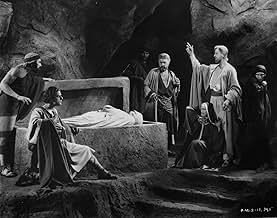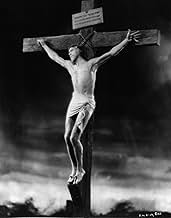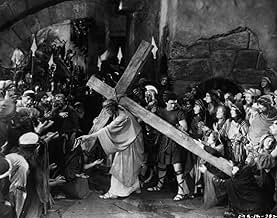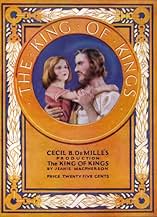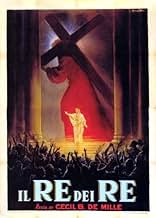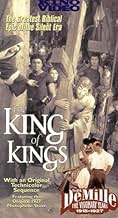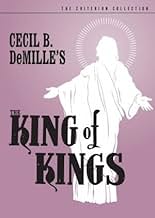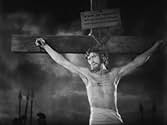CALIFICACIÓN DE IMDb
7.3/10
2.6 k
TU CALIFICACIÓN
Jesucristo se enfrenta a la opresión religiosa y política durante su ministerio y en los días previos a su muerte y resurrección.Jesucristo se enfrenta a la opresión religiosa y política durante su ministerio y en los días previos a su muerte y resurrección.Jesucristo se enfrenta a la opresión religiosa y política durante su ministerio y en los días previos a su muerte y resurrección.
- Premios
- 5 premios ganados en total
- Dirección
- Guionista
- Todo el elenco y el equipo
- Producción, taquilla y más en IMDbPro
Opiniones destacadas
What a masterpiece! Visually stunning and deeply moving, even for the non-religious. DeMille was at his best in the silent era, and I have never seen the story of Christ told so beautifully. With more than a passing nod to nineteenth century Biblical painting, DeMille recreates the last days of Jesus' life in painstaking detail. He takes some liberty with chronolgy, and there is his trademark combination of religious fervour and delicious decadence. But the passion and sincerity are so strong that I'll be surprised if you don't shed a tear once or twice. And Joseph Schildkraut is stunning as Judas.
Eye-popping sets and superb photography combine with huge crowds of extras and excellent costumes to create one of the great epic films. And dig that opening orgy scene involving a scantily clad Mary Magdalene, a couple of old men, a leopard and a hunky charioteer leading a team of zebra! Wow! The first shot of Jesus is also cinema magic, an unforgettable moment. This film is superb.
Eye-popping sets and superb photography combine with huge crowds of extras and excellent costumes to create one of the great epic films. And dig that opening orgy scene involving a scantily clad Mary Magdalene, a couple of old men, a leopard and a hunky charioteer leading a team of zebra! Wow! The first shot of Jesus is also cinema magic, an unforgettable moment. This film is superb.
The King of Kings is a good movie for the Christian family to watch anytime, but especially around Christian holidays. I was surprised to find the movie quite inspirational. The use of lighting during the black and white periods of film was exceptional. Jesus actually glowed. I did find the use of color detracting from the film. The background music is quite lovely. It was so lovely, that it almost put me to sleep as I saw the movie late at night. But once I made it through the first hour, I was caught up in the music as well as the other film content.I was surprised to find actual singing voices in the movie. I expected the film to be silent. Some of the episodes portrayed seemed a bit mixed up as to when they happened, but they were unimportant details. The text had beautiful script and many times nearly leaped off the page as spoken words. I thought this version was better the 1961 version. I believe that a Christian family might want to include this movie as a permanent addition to their movie library. Popcorn may be okay, especially for the younger crowd, but once the film really gets going, you won't really need it -- it'll become a distraction. Enjoy the film!
Cecil B. DeMille's film about Jesus was made during a period in his career when he left Paramount and organized his own studio. Unfortunately for DeMille his studio went belly up after the stock market crash of 1929. The King of Kings is unquestionably the greatest film he made during that period.
But in DeMille's cinema gospel he eschewed the traditional Christmas story to be found in those four other gospels. DeMille begins his movie with a real lavish party at the home of a noted women of the town Mary Magdalene played by Jacqueline Logan. It's DeMille showing revelry at its best and most alluring.
Logan asks why one of her favorites, Judas Iscariot hasn't been attending her clambakes recently. She hears he's been hanging around with this carpenter from Nazareth reputed to have performed some miracles and who doesn't approve of her lifestyle.
That's it for Ms. Magadalene; she's not about to let this hick take one of her favorites away. Off in a chariot pulled by Zebras she goes after this carpenter. She finds H.B. Warner as Jesus doing one of the miracles and becomes a follower herself.
After this the film becomes a reverential straightforward account as you would find in the Bible.
Reverence and revelry, the hallmark of a DeMille film is found in equal measure in The King of Kings. H.B. Warner does a fine job in the lead role, he makes a saintly Jesus. I do wonder what led DeMille to cast Warner, to think of him in the first place. Warner was 52 at the time playing a 30 something Jesus.
The King of Kings offers the movie fan to see father and son Rudolph and Joseph Schildkraut who play Caiaphas and Judas. Both contribute fine performances to the endeavor. Unlike later gospel based films, this one clearly has Caiaphas as the villain of the piece. He's described in the subtitles as a man concerned more with 'revenue than religion' which doesn't make him all that different from some folks I could mention today. The Schildkrauts however were Jewish and stars in the Yiddish Theater in Europe and America. They got good and slammed for their participation in The King of Kings by more than a few of their co-religionists.
Sharp eyed viewers will also note that the guy playing Simon of Cyrene who helps Jesus with his cross is none other than Hopalong Cassidy, William Boyd. Boyd was a DeMille discovery and had previously starred in another DeMille production, The Volga Boatman. This of course was years before he became the idol of the nation's children.
In his autobiography DeMille goes into some detail about how Jeremiah Milbank helped him with the financing of the DeMille Studio from which The King of Kings was produced. After the initial run, Milbank set up a foundation in which prints of The King of Kings were copied and made available to various Christian mission groups free for their work. It's one reason why this particular film is never in any danger of being lost.
DeMille was told on at least one occasion that this was his greatest picture because there is no greater subject. It's arguably one of his best from a technical standpoint. Still for the hundreds of millions of affiliated Christians on the planet, The King of Kings certainly occupies a special place.
But in DeMille's cinema gospel he eschewed the traditional Christmas story to be found in those four other gospels. DeMille begins his movie with a real lavish party at the home of a noted women of the town Mary Magdalene played by Jacqueline Logan. It's DeMille showing revelry at its best and most alluring.
Logan asks why one of her favorites, Judas Iscariot hasn't been attending her clambakes recently. She hears he's been hanging around with this carpenter from Nazareth reputed to have performed some miracles and who doesn't approve of her lifestyle.
That's it for Ms. Magadalene; she's not about to let this hick take one of her favorites away. Off in a chariot pulled by Zebras she goes after this carpenter. She finds H.B. Warner as Jesus doing one of the miracles and becomes a follower herself.
After this the film becomes a reverential straightforward account as you would find in the Bible.
Reverence and revelry, the hallmark of a DeMille film is found in equal measure in The King of Kings. H.B. Warner does a fine job in the lead role, he makes a saintly Jesus. I do wonder what led DeMille to cast Warner, to think of him in the first place. Warner was 52 at the time playing a 30 something Jesus.
The King of Kings offers the movie fan to see father and son Rudolph and Joseph Schildkraut who play Caiaphas and Judas. Both contribute fine performances to the endeavor. Unlike later gospel based films, this one clearly has Caiaphas as the villain of the piece. He's described in the subtitles as a man concerned more with 'revenue than religion' which doesn't make him all that different from some folks I could mention today. The Schildkrauts however were Jewish and stars in the Yiddish Theater in Europe and America. They got good and slammed for their participation in The King of Kings by more than a few of their co-religionists.
Sharp eyed viewers will also note that the guy playing Simon of Cyrene who helps Jesus with his cross is none other than Hopalong Cassidy, William Boyd. Boyd was a DeMille discovery and had previously starred in another DeMille production, The Volga Boatman. This of course was years before he became the idol of the nation's children.
In his autobiography DeMille goes into some detail about how Jeremiah Milbank helped him with the financing of the DeMille Studio from which The King of Kings was produced. After the initial run, Milbank set up a foundation in which prints of The King of Kings were copied and made available to various Christian mission groups free for their work. It's one reason why this particular film is never in any danger of being lost.
DeMille was told on at least one occasion that this was his greatest picture because there is no greater subject. It's arguably one of his best from a technical standpoint. Still for the hundreds of millions of affiliated Christians on the planet, The King of Kings certainly occupies a special place.
King of Kings, The (1927)
**** (out of 4)
It's interesting that Mel Gibson was originally going to show The Passion of the Christ without any subtitles because he felt the story spoke loudly enough and that audience members would know the story well enough so words weren't really needed. With The King of Kings being a silent film the silence really adds to the story but on the other hand, unlike Gibson it's very apparent that DeMille wasn't quite sure whether the audience would know the story good enough and that leads to the film's one weak spot. The film probably would have lost a good twenty-minutes if it weren't for all the intertitles, which become quite annoying because it's easy to read the lips of what the actors are saying. Even with that one flaw DeMille created one of the greatest tellings of the story of Jesus.
The first hour and half deals with Jesus (H.B. Warner) as he walks the Earth with his disciples where he cures the blind and helps the cripple to walk. The second hour then turns to the crucifixion and eventual resurrection and with each passing frame you can tell this is a film being made by someone very passionate about the subject matter. The great lengths DeMille went through to create this film have become somewhat legendary. The director would have ministers bless the film each day before filming and even made his actors sign papers swearing they wouldn't get into any trouble to where the audiences might not believe them in their part.
I find it quite odd to bash a religious film for not staying true to the source material because no movie ever has and I'm sure one never will. DeMille adds some interesting changes including having Mark be a young boy who is cured by Jesus but the most infamous change is the romance between Judas and Maria Magdalene. According to the liner notes, this so-called romance was a German legend but why DeMille decided to use it is anyone's guess. DeMille also said that the Jews were the most unfairly treated in the Bible and to avoid any anti-Semitic controversy, it's made quite clear that Rome was behind the deeds of that certain day.
As I said earlier, The King of Kings is epic in scale but DeMille thankfully never goes over the top and remembers that the story is the most important thing to make a movie work. Each and every frame is told in such loving care that it doesn't take any time for the film to transfer you back and make it seem as if you're actually there witnessing these events on your own. The lavished sets and thousands of extras also add a great deal of realism to the story and W.B. Warner, while a bit too old for the role, delivers a remarkable performance where he tells every feeling of Jesus with a simple look or body gesture.
The film is also quite moving especially the scenes with Jesus working with a group of sick people. DeMille usually slows the pace down so that we can see the love these sick people felt for Jesus and that clearly jumps right off the screen. DeMille also makes sure to show Jesus as a mythical character who can work wonders and most importantly, the film allows Jesus to be seen as someone who knows what love is and knows his mission in life.
When Jesus is working these wonders the director usually has a light shining on him, which would come off as camp but once again DeMille knew how far to push this and the effect works quite nicely. Another wonderful thing is that DeMille allows some humor to be thrown in with the off-screen violence. The best example of this is the guards getting ready to put the crown of thorns on Jesus but they keep hurting their hands trying to make it.
Another wonderful scene has a little girl asking Jesus to heal her doll, which has had a leg broken off.
Perhaps this was the showman side of DeMille coming into play but the director decided to film the resurrection with Technicolor. In the 1927 "Premier" version, Technicolor is also used at the very beginning of the film but soon fades to black and white when Jesus is introduced. The resurrection sequence with the use of color perfectly brings the detail of a life returning back to the Earth. It's rather hard to put it into words but when the B&W fades and the color comes shining through, with this little experiment DeMille is able to create some wonderful emotions and get his point across very quietly.
There have been dozens of religious movies since The King of Kings (including a remake) but I feel this one here is a film that would appeal to everyone no matter what their personal beliefs are. This is classic DeMille, which shows his talent at storytelling as well as his showmanship of delivering a spectacle like no other.
**** (out of 4)
It's interesting that Mel Gibson was originally going to show The Passion of the Christ without any subtitles because he felt the story spoke loudly enough and that audience members would know the story well enough so words weren't really needed. With The King of Kings being a silent film the silence really adds to the story but on the other hand, unlike Gibson it's very apparent that DeMille wasn't quite sure whether the audience would know the story good enough and that leads to the film's one weak spot. The film probably would have lost a good twenty-minutes if it weren't for all the intertitles, which become quite annoying because it's easy to read the lips of what the actors are saying. Even with that one flaw DeMille created one of the greatest tellings of the story of Jesus.
The first hour and half deals with Jesus (H.B. Warner) as he walks the Earth with his disciples where he cures the blind and helps the cripple to walk. The second hour then turns to the crucifixion and eventual resurrection and with each passing frame you can tell this is a film being made by someone very passionate about the subject matter. The great lengths DeMille went through to create this film have become somewhat legendary. The director would have ministers bless the film each day before filming and even made his actors sign papers swearing they wouldn't get into any trouble to where the audiences might not believe them in their part.
I find it quite odd to bash a religious film for not staying true to the source material because no movie ever has and I'm sure one never will. DeMille adds some interesting changes including having Mark be a young boy who is cured by Jesus but the most infamous change is the romance between Judas and Maria Magdalene. According to the liner notes, this so-called romance was a German legend but why DeMille decided to use it is anyone's guess. DeMille also said that the Jews were the most unfairly treated in the Bible and to avoid any anti-Semitic controversy, it's made quite clear that Rome was behind the deeds of that certain day.
As I said earlier, The King of Kings is epic in scale but DeMille thankfully never goes over the top and remembers that the story is the most important thing to make a movie work. Each and every frame is told in such loving care that it doesn't take any time for the film to transfer you back and make it seem as if you're actually there witnessing these events on your own. The lavished sets and thousands of extras also add a great deal of realism to the story and W.B. Warner, while a bit too old for the role, delivers a remarkable performance where he tells every feeling of Jesus with a simple look or body gesture.
The film is also quite moving especially the scenes with Jesus working with a group of sick people. DeMille usually slows the pace down so that we can see the love these sick people felt for Jesus and that clearly jumps right off the screen. DeMille also makes sure to show Jesus as a mythical character who can work wonders and most importantly, the film allows Jesus to be seen as someone who knows what love is and knows his mission in life.
When Jesus is working these wonders the director usually has a light shining on him, which would come off as camp but once again DeMille knew how far to push this and the effect works quite nicely. Another wonderful thing is that DeMille allows some humor to be thrown in with the off-screen violence. The best example of this is the guards getting ready to put the crown of thorns on Jesus but they keep hurting their hands trying to make it.
Another wonderful scene has a little girl asking Jesus to heal her doll, which has had a leg broken off.
Perhaps this was the showman side of DeMille coming into play but the director decided to film the resurrection with Technicolor. In the 1927 "Premier" version, Technicolor is also used at the very beginning of the film but soon fades to black and white when Jesus is introduced. The resurrection sequence with the use of color perfectly brings the detail of a life returning back to the Earth. It's rather hard to put it into words but when the B&W fades and the color comes shining through, with this little experiment DeMille is able to create some wonderful emotions and get his point across very quietly.
There have been dozens of religious movies since The King of Kings (including a remake) but I feel this one here is a film that would appeal to everyone no matter what their personal beliefs are. This is classic DeMille, which shows his talent at storytelling as well as his showmanship of delivering a spectacle like no other.
This Cecil B. DeMille silent classic is still well worth seeing. It is creative and interesting, while remaining respectful to its subject, and thus it is among the best of the many movies made about Jesus. Unlike most directors (especially today), DeMille did not think that he was bigger than his subject, and thus he uses his skills to illustrate the well-known story and to make it memorable, rather than expending time and energy in trying to push some trivial perspective of his own. He makes it lavish when it should be lavish, and keeps it simple when it should be simple.
The opening scene, with Mary Magdalene and her admirers hearing bits of news regarding Jesus and Judas Iscariot, is a good introduction to the rest of the story, and also sets the tone for what follows. While it is a fictionalized scene not found in the Bible, it seems natural and works well. The rest of the movie likewise does not always follow the biblical narratives exactly, but the added material is always in keeping with the main themes. The cast is pretty good, although given the nature of the story, most of them have limited screen time. H.B. Warner looks just a little too old to be fully convincing as Jesus, but otherwise he is good enough in a difficult role. Probably the best performance is given by Joseph Schildkraut as Judas. He is quite believable, and is especially good in the Last Supper scene. His father Rudolph is also good in a smaller role as the high priest Caiaphas.
With the vast number of movies that are always being made about religious subjects, no doubt it will only be silent movie fans who will seek out this version of "The King of Kings", but that's unfortunate because it is nicely made and has many positives that make it worth seeing.
The opening scene, with Mary Magdalene and her admirers hearing bits of news regarding Jesus and Judas Iscariot, is a good introduction to the rest of the story, and also sets the tone for what follows. While it is a fictionalized scene not found in the Bible, it seems natural and works well. The rest of the movie likewise does not always follow the biblical narratives exactly, but the added material is always in keeping with the main themes. The cast is pretty good, although given the nature of the story, most of them have limited screen time. H.B. Warner looks just a little too old to be fully convincing as Jesus, but otherwise he is good enough in a difficult role. Probably the best performance is given by Joseph Schildkraut as Judas. He is quite believable, and is especially good in the Last Supper scene. His father Rudolph is also good in a smaller role as the high priest Caiaphas.
With the vast number of movies that are always being made about religious subjects, no doubt it will only be silent movie fans who will seek out this version of "The King of Kings", but that's unfortunate because it is nicely made and has many positives that make it worth seeing.
¿Sabías que…?
- TriviaCecil B. DeMille did not want to take any chances with the film. His two stars, H.B. Warner and Dorothy Cumming, were required to sign agreements which prohibited them from appearing in film roles that might compromise their "holy" screen images for a five-year period. DeMille also ordered them not to be seen doing any "un-Biblical" activities during the film's shooting. These activities included attending ball games, playing cards, frequenting night clubs, swimming, and riding in convertibles.
- ErroresIn the first scene in Mary Magdalene's house, studio lights are reflected in a large hand-held mirror.
- Citas
Mary Magdalene: Harness my zebras--gift of the Nubian King! This Carpenter shall learn that he cannot hold a man from Mary Magdalene!
- Créditos curiososIn the original premiere version, there is no 'THE END' title. The film fades to black after the final scene of Jesus looming over a modern city with the title 'LO, I AM WITH YOU ALWAYS' superimposed.
- Versiones alternativasThe 1927 premiere, the first film shown at Grauman's Chinese Theatre, ran 155 minutes. The film later was cut to 112 minutes for general release.
- ConexionesEdited into Tingen, Edderkoppen 2: Bivirkninger (2013)
Selecciones populares
Inicia sesión para calificar y agrega a la lista de videos para obtener recomendaciones personalizadas
- How long is The King of Kings?Con tecnología de Alexa
Detalles
- Fecha de lanzamiento
- País de origen
- Idioma
- También se conoce como
- Kralj kraljev
- Locaciones de filmación
- Santa Catalina Island, Channel Islands, California, Estados Unidos(Sea of Galilee scene)
- Productora
- Ver más créditos de la compañía en IMDbPro
Taquilla
- Presupuesto
- USD 2,500,000 (estimado)
- Tiempo de ejecución2 horas 40 minutos
- Color
- Mezcla de sonido
- Relación de aspecto
- 1.33 : 1
Contribuir a esta página
Sugiere una edición o agrega el contenido que falta

Principales brechas de datos
By what name was The King of Kings (1927) officially released in India in English?
Responda

